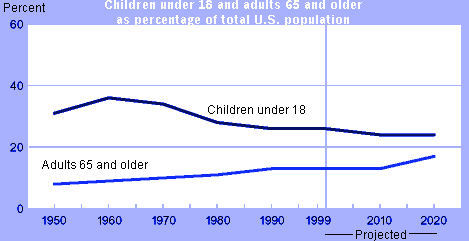
There is a delicate balance that exists between social and personal needs, a balance that changes historically. The relative size of age strata within a community does not remain static, upsetting the previous balance. The changes in population size, both in relative and proportional size, such as the growing elderly population, exert pressures on both the physical and social environment. When the size of an age strata is large, like the growing aging population, the equilibrium between needs and services falls into a state of disequilibrium. Because of declining numbers of young people, local high schools in towns like Ackerly, Texas, now field 6-person football teams. Surplus schools may be converted into housing units for the elderly, student discounts may be replaced with senior discounts, and the lettering of highway signs may have to be increased.
Factoids:

Over the past two decades, I have followed a number of ways in which communities have responded to their elderly members. Some of these responses include:


Contrary to stereotypes, the flow of services between older persons and their communities goes both ways (click here for analyses of how volunteerism varies by age). According to the 1994 AARP study referenced above we find fully one-half of American adults acknowledging the contributions of older people:
| AGE: | MALES | FEMALES |
| 18-34 | 48% | 44% |
| 35-49 | 52 | 57 |
| 50-64 | 52 | 51 |
| 65-74 | 56 | 47 |
| 75+ | 22 | 44 |
| TOTAL | 49% | 50% |
At the 2004 annual meetings of the Gerontology Society of America launched a five-year initiative, "Civic Engagement in an Older America," to study and encourage the civic participations of the old--particularly those of the Boomer generation.

Car Wars? Intergenerational relations on the road. According
to the 1994 AARP "Images of Aging" study we find:
PERCENT AGREEING
DRIVERS 65+
HAVE FEW ACCIDENTS
|
AGE: |
MALES |
FEMALES |
|
18-34 |
45% |
41% |
|
35-49 |
51 |
42 |
|
50-64 |
60 |
40 |
|
65-74 |
62 |
74 |
|
75+ |
65 |
63 |
|
TOTAL |
52% |
46% |
![]()